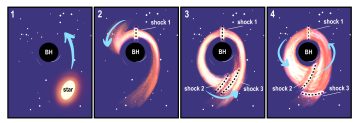Tidal Shocks Can Light up the Remains of a Star Being Pulled Apart by a Black Hole
A new study led by FINCA researchers sheds light on the bright outbursts of radiation that are created when a star is destroyed by a supermassive black hole. The outbursts do not necessarily form in the close vicinity of the black hole, but are created by tidal shocks that occur when gas from the destroyed star hits itself while circling the black hole. It was published in Science and you can read more also here.

In a Tidal Disruption Event, a star moves close enough to a supermassive black hole so that the gravitational pull of the black hole bends the star until it is destroyed (image 1). The stellar matter from the destroyed star forms an elliptical stream around the black hole (image 2). Tidal shocks are formed around the black hole as the gas hits itself on its way back after circling the black hole (image 3). The tidal shocks create bright outbursts of polarised light that can be observed in optical and ultraviolet wavelengths. Over time, the gas from the destroyed star forms an accretion disk around the black hole (image 4) from where it is slowly pulled into the black hole. The scale of the image is not accurate. Image: Jenni Jormanainen